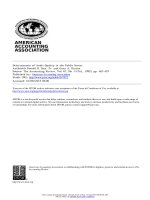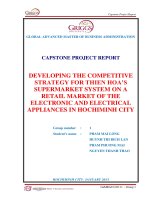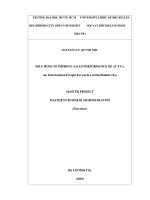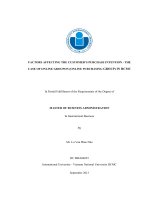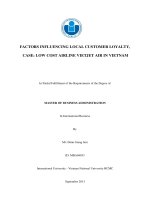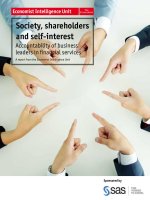FACTORS INFLUENCING ORGANIZATIONAL COMMITMENT AND INTENTION TO STAY OF CORE EMPLOYEES IN SMALL - MEDIUM SIZED COMPANIES IN HOCHIMINH CITY
Bạn đang xem bản rút gọn của tài liệu. Xem và tải ngay bản đầy đủ của tài liệu tại đây (515.94 KB, 79 trang )
UNIVERSITY OF ECONOMICS HO CHI MINH CITY
International School of Business
Huỳnh Thiên Hải
FACTORS INFLUENCING
ORGANIZATIONAL COMMITMENT
AND INTENTION TO STAY OF
CORE EMPLOYEES IN
SMALL - MEDIUM SIZED COMPANIES
IN HOCHIMINH CITY
MASTER OF BUSINESS (Honours)
Ho Chi Minh City - Year 2012
UNIVERSITY OF ECONOMICS HO CHI MINH CITY
International School of Business
Huỳnh Thiên Hải
FACTORS INFLUENCING
ORGANIZATIONAL COMMITMENT
AND INTENTION TO STAY OF
CORE EMPLOYEES IN
SMALL - MEDIUM SIZED COMPANIES
IN HOCHIMINH CITY
ID: 60340102
MASTER OF BUSINESS (Honours)
SUPERVISOR
Dr. NGUYỄN THỊ NGUYỆT QUẾ
Ho Chi Minh City - 2012
INDEX
ACKNOWLEDGEMENTS 5
LIST OF FIGURES 6
LIST OF TABLES 6
LIST OF APPENDIX 7
ABSTRACT 9
1.1. Background to the research 10
1.1.1 The importance of small and medium sized companies 10
1.1.2. The facts of labor force in SMEs and problem statement 10
1.2. Research objective 12
1.3. Scope of the study 12
1.4. Significances of the study: 12
1.5. Structure of the study 13
CHAPTER 2: LITERATURE REVIEW 14
2.1. Chapter introduction 14
2.2. Relative concepts and definition 14
2.2.1.Small and medium companies 14
2.2.2. Core employees 15
2.2.3. Core employee retention 15
2.3. Review of previous study 17
2.3.1. Organizational commitment 18
2.3.2. Training 19
2.3.3. Leadership 19
2.3.4.Working environment 20
2.3.5. Remuneration and reward 21
2.3.6. Organizational culture and policies 22
3.3.7. Intention to stay 22
2.4. Proposal research hypotheses 23
2.5. Chapter conclusion 24
CHAPTER 3: METHODOLOGY 25
3.1 Research process 25
3.2. Questionnaire design 26
3.2.1 Measure of variable 26
3.2.2. Draft questionnaire 30
3.3. Pilot study 30
3.4 Main survey 31
3.4.1. Sample method 31
3.4.2. Sample size 31
3.5. Data analysis technique 32
3.5.1. Recoding data 32
3.5.2. Testing of Reliability 32
3.5.3. Exploratory factor analysis (EFA) 33
3.5. 4. Hypotheses testing: Multiple Regression Analysis 33
3.7. Chapter conclusion 34
CHAPTER 4: DATA ANALYSIS 35
4.1. Sample description and data clearance 35
4.2. Demography Sampling 35
4.4. Testing of Reliability 36
4. 5. Exploratory factor analysis (EFA) 37
4.7. Chapter conclusion 43
5.1. Finding and discussion 45
5.2. Limitation 46
5.3. Suggestion for future Research 47
APPENDIX 55
APPENDIX 1.1: QUESTIONAIRE (English version) 55
APPENDIX 1.2: QUESTIONAIRE (Vietnamese version) 59
APPENDIX 4.1 CODING 62
Appendix 4.2 Demography 65
Appendix 4.3: Testing of reliability variables 65
Appendix 4.4 . EFA for all independent variables 67
Appendix 4.4 .1. EFA for all independent variables (The first time in 4 times) 67
Appendix 4.4.2: EFA with all independent variable (the second time in 4 times) 68
Appendix 4.4 .3. EFA for all independent variables (The third time in 4 times) 70
Appendix 4.4 .4. EFA for all independent variables (The fourth time in 4 times) 71
Appendix 4.5. Regression, model 1. Independent variables: Training, leadership,
remuneration and company policies; dependent variable: Commitment 73
Appendix 4.6. Regression, model 2. Independent variables: Organizational Commitment;
dependent variable: intention to stay 76
5
ACKNOWLEDGEMENTS
First at all, I would like to express my sincere gratitude to my supervisors, Dr.
Nguyen Thi Nguyet Que for her continuous support of my thesis.
I would like to take this opportunity to thank leaders, teachers and staffs in ISB who
help me usefully all the subjects of my master course.
My sincere thanks also goes to the friends and colleagues who participated in the
initial trial survey stages that led to the development of the final survey questionnaire and
their support over the time when I am busy to study.
I would like to thank my Mummy, my sisters, brothers and my special friend who is
my moral support in all my studying period.
Last at all, I would like to present the achievement to my Dad's soul who spent all the
life for my family
Ho Chi Minh City, December 28, 2012
Huynh Thien Hai
6
LIST OF FIGURES
Name of configure Page
Figure 2.1 proposal research hypothesis 24
Figure 3.1 Research Design Process 26
Figure 4.1 Final model
44
LIST OF TABLES
Table name Page
Table 2.1. Classification of SMEs in Vietnam 16
Table 3.1. Measurement of training and career
development
27
Table 3.2. Measurement of leadership
27
Table 3.3. Measurement of working environment
28
Table 3.4. Measurement of remuneration and
rewards
29
Table 3.5. Measurement of company policies 29
Table 3.6. Measurement of organizational
commitment
30
Table 3.7. Measurement of intention to stay
30
Table 3.8: Cronbach’s alpha reliability coefficient
33
Table 4.1 Sample Demography 37
Table 4.2: Cronbach’s alpha reliability coefficient
of variable 37
Table 4.3: Pattern matrix in the last time (the fourth
time) of regression analysis 37
Table 4.4 Correlations model 1 40
Table 4.5 Model Summary
b
model 1 40
Table 4.6 ANOVA of model 1 41
Table 4.7. Coefficients
a
of medel 1 41
Table 4.8 Model Summary
b
model 2 43
Table 4.9. Coefficients
a
of model 2 43
Table 5.1. Questionnaire for organizational polices 46
7
LIST OF APPENDIX
Appendix name Page
APPENDIX 1.1: ENGLISH QUESTIONAIRE
55
APPENDIX 1.2: VIETNAMESE QUESTIONAIRE
50
APPENDIX 4.1 CODING
62
Appendix 4.2 Demography
65
Appendix 4.3: Testing of reliability of variables
65
Appendix 4.4. EFA for all independent variables 67
Appendix 4.4 .1. EFA for all independent variables (The first
time in 4 times)
67
Appendix 4.4.2: EFA with all independent variable (the
second time in 4 times)
68
Appendix 4.4 .3. EFA for all independent variables (The third
time in 4 times)
70
Appendix 4.4 .4. EFA for all independent variables (The
fourth time in 4 times)
71
Appendix 4.5.Correlation bivariable model 1 73
Appendix 4.5.Correlation bivariable model 2 76
8
LIST OF ABBREVIATION
SME Small and medium sized company
SMEs Small and medium sized companies
HCMC Hochiminh City
VCCI Vietnam Chamber of Commerce and Industry
HR Human resource
VND Vietnam Dong
WTO the World Trade Organization
WB World Bank
9
ABSTRACT
Employee retention especially core employees is one of the most important ongoing
practices of human resource management. Employee’s turnover is a major HR organizational
threat. The problem is being faced by different organizations of almost all the countries.
Organizations are trying different plans to get maximum output from employees. Core
employee retention is one of the main factors that could help in achieving the required
results.
There are many theories for retention employees but there is not any closed research for
SME employees in HCMC.
This study elaborates the retention of core employees; its benefits and factors that may help
to retain the best employees of the organization.
Questions with five-point Likert scale are used to the research for investigating needs of core
employees. Base on the result of investigation, the most affective factors among of factors:
training-career path; leadership; working environment ; remuneration-rewards and
organizational culture-policies will be recognized. Intermediary variable is organizational
commitment that is used in the research.
The research findings prove significant relationship of training-career path; leadership;
working environment; remuneration-rewards and organizational culture-policies that
influence the staying decision of core employee. This study will help SMEs in HCMC to find
out various HR policies and to revise their current policies for further improvements.
10
CHAPTER I: INTRODUCTION
1.1. Background to the research
1.1.1 The importance of small and medium sized companies
Small and medium sized companies (after here called by SMEs) are important to almost all
economies in the world. SMEs are main element in all economics, in Europe, there are 57
per cent of 1- person enterprises, 34 per cent of micro enterprises (less than 10 employees);
7.7 per cent of small enterprises; 1per cent of medium, totally of SME is 99.7 per cent but
there are only 0.27 per cent of large companies and 0.03 per cent of Stock Exchange (Agnès,
2010). SMEs in Russia (with up to 250 employees) account for about 90 per cent of the total
number of firms, they provide 45 per cent of total employment and they account for 40 per
cent of total sales; SMEs in China account for 99.9 percent of the total number of firms, they
provide 84 per cent of total employment and account for 71 percent of total sales (Qimiao,
2003).
General Statistics Office (2012) reported SMEs are approximately 97 per cent of 448.393
companies in Vietnam and they represent the main drivers in obtaining employment and
VCCI (2012) reported SMEs contribute 60 per cent GDP in Vietnam with the capital of 6
million billion VND
1.1.2. The facts of labor force in SMEs and problem statement
Although there are many important SME's distribution, they still face many problems in HR,
the demands for the human resource is increasing and the lack of the right personnel,
especially in the management personnel, prevent the SMEs development.
One of the specifications of HR in SMEs is not clearly function between administration and
human resource such as administration usually is responsibility recruitment function in
SMEs, but that are 2 different functions of HR in the organization (Torben., 2003)
SMEs is very hard to completive with other organization type to attract qualified employee
because there is not clearly policies to intent them. According to a recent poll of
undergraduates and recent graduates of the three local universities, Singapore Management
11
University (SMU), National University of Singapore (NUS) and Nanyang Technological
University (NTU), MNCs, as a category, still outstrip SMEs as employers of choice.
Recruitment firm Jobs Factory, which polled over 4,500 students, revealed that in this year’s
survey, the top five employers of choice in the private sector are Apple, Singapore Airlines,
Google, 3M and DBS Bank – all large companies with operations across the world. It is not
difficult to see why job seekers flock to MNCs. Besides the easily-recognizable brand
names, they are also seen as organizations that are more transparent, offer higher
remuneration, superior benefits and strong organizational structure – all of which point to
better career prospects. Recent surveys have highlighted that culture and
work-life balance are important to the younger generation, and bigger firms are perceived to
be more flexible – or at least, more open to suggestion – in these areas. Conversely, SMEs
are often seen to be non-transparent, authoritarian and less professional (than MNCs). More
often than not, the founder/boss’ inner circle is made up of family and relatives, with
competence a secondary consideration. (Developing an Argument, 2010)
Employee working life in SMEs is short, most of employee think SMEs is temporary place,
so they do not have any long term plan for the SME. The other specification of employees in
SMEs is they are not confident working, always waiting direction for leader.
The studies indicated that the work relationship between the employer and the employee in
SME’s is not generally governed by a contract. Only (15%) of the workers had a contract (El
Mahdi, Nov.1999). The lack of contract may just be a reflection of the traditional and
informal environment in which SME’s is conducting its affairs. So, the most important issue
of SME’s is the insecurity of the workers regarding their future, due to the lack of social
security coverage and due to the fact that employers are not bound by any contract towards
their employees.
The previous studies indicated that although the provision of technical and other aspects of
running the small firms are highly needed, the training assistance that is offered to small
enterprises through the different programs of support and finance is almost negligible.
According to the study of Soliman et al., (1998) only 66.9% of the studied projects indicated
12
that they did not get any kind of assistance, especially training, from the finance providers.
Despite the fact that a few studies tackled the issue of small enterprises, employment and
micro-finance, none of these research tried to assess the kind of relationship that exists
between offering micro finance and employment creation in the small enterprises.
There are many reasons (or factors) are influencing employee but there is no study that
researches what the factors more affect to employee, which factors are influencing
organizational commitment and intention to stay of employee in the SMEs. Those questions
are the problem of labour force in SMEs and that will be answered in the study.
1.2. Research objective
In the thesis, we will review relevant theories and previous researches on factors that have
impact on the intention to stay of core employees stay in SMEs. Specially, the study will
investigates what factors influencing the intention to stay of core employees and measure
how deep the influencing factors effect organizational commitment and intention to stay of
core employees.
1.3. Scope of the study
Purpose of the research investigate and determine the factors the affective staying decision of
core employees in SMEs, it will exam the relative between the factors and identify the
factors which are strongly affective the organizational commitment and intention to stay of
core employees in SMEs. The result of this research can be applied to SMEs in HCMC and
help SME directors re-construct company and give new human resource policies that to
retain core employees
1.4. Significances of the study:
HCMC is the biggest trading, financial and service center of Vietnam. There are over
170.000 SMEs, among of 38 per cent of SMEs in Vietnam. SMEs in HCMC is very flexible
so they are not only achieve the best result but also get bad influence with any negative
chances. There are many companies among 26.324 companies that quit in 6 months in
beginning 2012 face difficult situation to retain core employees. Because of the importance
13
of core employees and their position of HCMC, this research focus in retention core
employees in SMEs in HCMC.
In general, core employees are normal employees with some special specification such as
working period, their importance in organizations, So besides normal requested as normal
employees, they need more request and to meet their requests is one of the key to retain them
in organizations. In next chapter, the study will show the request of core employees
1.5. Structure of the study
The study consists of five main content
Introduction: Overview of SMEs such as the importance of SMEs, the facts of labor force
in SMEs, research objective, scope of study and Significances of the study
Literature review: Some relative concept and definition of the study will be explained in
this chapter such as small and medium companies, core employees, core employee retention
as well as review of previous study about training and Career path; leadership; working
environment; remuneration & reward; organizational culture and policies; organizational
commitment and intention to stay. Proposal research hypotheses will be introduced in this
chapter
Methodology: Research process will be introduced in this chapter. This chapter also
introduces the methodologies of questionnaire design, measure of variable, draft
questionnaire, pilot study as well as the way to collect data and methodologies of data
analysis.
Data analysis: Collected data will be analyzed in this chapter. This analysis include testing
of Reliability, exploratory factor analysis (EFA) and hypotheses testing: Multiple Regression
Analysis
Finding, discussion, limitation and suggestion for future study : This is the result of the
study distribution of study for theory and applied, the limitation of the study and suggest to
later study
14
CHAPTER 2: LITERATURE REVIEW
2.1. Chapter introduction
There are many previous study for the factors that influencing organizational commitment
and intention to stay of core employee in the world. In this chapter, the definition of core
employee, SMEs, core employee retention and the factors influencing organizational
commitment and intention to stay of core employee are introduced. Hypotheses, proposal
scales are introduction is also showed in this chapter
2.2. Relative concepts and definition
2.2.1.Small and medium companies
That is synonymous definition between small and medium companies and small and
medium sized enterprises. The abbreviation "SME" for small and medium sized companies
is used in the European Union and by international organizations such as the WB, and WTO.
The term "small and medium businesses" (or SMBs) is predominantly used in the USA. In
most economies, smaller enterprises outnumber large companies by a wide margin. SMEs
are said to be responsible for driving innovation and competition in many economic sectors.
Wikipedia (2012) defined that are the companies whose personnel number fall below certain
limit. The certain limits are different from the countries. The EC definite SMEs are three
broad parameters which define SMEs: micro-entities are companies with up to 10
employees; small companies employ up to 50 workers, whilst medium-sized enterprises have
up to 250 employees.
In Vietnam, Decree No. 56/2009/ND-CP dated 30/6/2009 of the Government defined SMEs
are the organizations that are less than 200 employees or capital less than 100 billion
Vietnam Dong,. More detail show in table 2.1
15
Table 2.1: Classification of SMEs in Vietnam (Decree No. 56/2009/ND-CP)
Scope of business Micro
company
Small company Medium company
Employees Employees Capital (bil) Employees Capital (bil)
Agriculture, Forestry, Less 10 10-200 Less 20 20-200 20-100
Industry and
construction
Less 10 10- 200 Less 20 20-200 20-100
Trading and services Less 10 10-50 Less 10 50-100 10-50
2.2.2. Core employees
Core employee are permanent employees comprising the central and foundational group that
provides the skills essential to the survival and growth of an organization. Core employees
are supported in their work by contingent or peripheral employees. (Business Dictionary)
Critical job functions will be retained by small group, relatively permanent "core" of
employees with board skill allowing them to tackle a variety of jobs (Janet, 2004). As
definition from Renee (2012) a core employee is a full-time attendance. Core employee
usually are required to work at least 40 hours per week. Core employees are necessary for a
business to function. A contingent worker is usually a temporary worker.
Definition of core employee in the research is person who works full time (Renee, 2012),
they are the persons who respond multi job and affect on other person (Janet, 2004) and
work for organization more than 6 months
2.2.3. Core employee retention
Once a SME finds an employee, it's very hard to find knowledgeable people who is suitable
to expect position because some disadvantage of SMEs. Hiring knowledgeable people for
the job is essential for an employer. But retention is even more important than hiring. In
order to keep employees motivated and willing to stay with the organization, the company do
not only pay more but also make motivation working environment.
16
Harvard Manage Mentor Journal (2012) said Core employee retention is to keep that people
who will help the organization remain competitive to competitors in the market
In other hand, when core employee leaves, the organization will loss many things: the
turnover is high so the cost of turnover (including hiring costs, training costs and
productivity loss) is high; When an employee leaves, valuable knowledge about the
company, customers, current projects and past history will go with him, employer must pay
much time and money has been spent on the employee in expectation of a future return.
When the employee leaves, the investment is not realized; customers and clients do business
with a company in part because of the employee. Relationships are developed that encourage
continued sponsorship of the business. When an employee leaves, the relationships that
employee built for the company are severed, which could lead to potential customer loss.
When an employee terminates, the effect is felt throughout the organization. Co-workers are
often required to pick up the slack. The unspoken negativity often intensifies for the
remaining staff. The goodwill of a company is maintained when the attrition rates are low.
Higher retention rates motivate potential employees to join the organization. If an employee
resigns, then good amount of time is lost in hiring a new employee and then training him/her
and this goes to the loss of the company directly which many a times goes unnoticed. And
even after this you cannot assure us of the same efficiency from the new employee
Employee retention is beneficial for the organization as well as the employee. They are not
the ones who don’t have good opportunities in hand. As soon as they feel dissatisfied with
the current employer or the job, they switch over to the next job, and when they left, with
their effectiveness, other employees will be left or their willing go down in a period A good
employer should know how to attract and retain its employees.
The question of SME leaders is how to retain their employee, especially core employee as
long as possible. The problems that are companies should found desire of core employees,
but that is very difficult because each employee has different desire even it are different in
each stage of their life.
17
2.3. Review of previous study
Best employees searching will be very difficult things in coming years for organizations,
core employee retention is a process not only to maintain existing core employees but also
recruits right person to appropriately position. In the scope of study, researcher studies
factors to maintain core employees in SMEs
There are several previous research about employee retention topic with various result and
ideas to applied to organizations.
Retention can be possible by many ways but one of the most used in organizations is paying
more than they are earning. Hansen (2002) argued that pay more to the employees in order to
achieve better financial position and retain those employees who lead from the front to attain
business goals. Short and long term incentives should be given according to the goals of
business that will help to have more organized and strong management team for long term
results. Lawler II (2005) stated that in these days organizations are competing for talent
rather than counting employees loyalty. They are focusing on attracting, hiring and retaining
the required core persons. For this purpose organizations must utilize those practices which
are in favor of both employees and employers leading them towards higher performance
levels.
We have closed look to development of employee retention concept to now (2012):
From 1975, Dubin et al., found a strong relationship between central life interests of
workers and their commitment to the organization. This research show the relationship
between work value and commitment to the organization.
Ans et al., (2003) found employee’s staying in decision has found some positive effects on
the job content, social atmosphere, work-life balance, career development.
Janet (2004) in her PhD thesis for retention of core employee in SMEs in Australia, argued
that core employees retention higher if they get high human commitment: with human
resource practice and organization factors such as selection (organization fit), remuneration
and rewards. Training and career develop, challenging work and opportunities and
18
organization commitment such as leadership, team work, organizational culture and policies,
work environment;
Prateek et al., (2011) said Organization commitment (ownership, loyalty, attachment),
Career Advancement (career needs, career path, career planning and management), quality of
work life (fair compensation, working condition, job Involvement) has some direct and
independent effects organizational commitment and intention to stay of core employee.
Bhavna & Swati (2012) researched the quality of working relationships, workplace
leadership, having a say, clear values, being safe, the built environment, recruitment, pay and
conditions, getting Feedback, autonomy and uniqueness, a sense of ownership and identity,
learning, passion, having fun, community connections, that can influence iorganizational
commitment and intention to stay of core employee in the organization
2.3.1. Organizational commitment
The concept of organizational commitment has attracted considerable attention over recent
years and has become a central objective of human resource management. As Guest (1987)
indicated, HRM policies are designed to maximize organizational integration, employee
commitment, flexibility and quality of work. For the topic in question our focal interest
refers to “Commitment ” which can be described as attachment and loyalty. Individuals can
display this attachment and loyalty at a variety of levels: their job, profession, department,
boss or organization. Realistically then, commitment may therefore be diverse and divided
between any of these. More specifically, organizational commitment has been defined by
Mowdray (1992) as consisting of three components: an identification with the goal’s and
values of the organization, a desire to belong to the organization and a willingness to display
effort on behalf of the organization.
Shorter meaning of organizational commitment in the study that is satiability of core
employees in SMEs
19
2.3.2. Training
That definition is called by different way by the authors: Learning, training opportunities
(Bhavna. & Swati., 2012; Waleed., 2011) training and career development (Muhammad,
2011), coaching (Liette, 2010), training and development, (Mohammad A. & Mohd H.R. J.,
2009), learning and development (Andy et al., 2003), amount of training available, training
methods (Karen, 2001), training and career develop (Janet, 2004)
As Dawn R. Mc. K (2012) Career development, a major aspect of human development, is the
process through which an individual's work identity is formed. It spans one's entire lifetime.
Career development begins with a person's earliest awareness of the ways in which people
make a living, continues as he or she explores occupations and ultimately decides what
career to pursue, prepares for it, applies for and gets a job and advances in it. It may, and
probably will include, changing careers and jobs.
If the SME leaders help core employee set their career path, that is weapon to retain them
because they feel ensuring their jobs in the future Career path is a system which is organized,
formalized and it’s a planned effort of achieving a balance between the individual career
needs and the organization’s workforce requirements (Leiboiwitz et al, 1986).
H 1: Training and career path has positive impact on organizational commitment
2.3.3. Leadership
That was defined by different words as Workplace leadership (Bhavna & Swati, 2012)
Management style and lack of opportunities (Waleed, 2011), good leadership (Petra, 2011),
supervision (Kazi & Sisi, 2011), a sense of ownership and identity (Bhavna & Swati, 2012),
leadership behavior (Mohammad & Mohd, 2009), trust in supervisor (Fleischlin, 2008),
having a say (Agarwal & Gupta , 2012), supervisor support (Muhammad, 2011), leadership
(Janet, 2004)
20
Leadership is definite as behavior of an individual that result in none-coercive influent when
that person in directing and cooperating the activities of a group towards the accomplishment
of the shared goal (Bryman, 1992). That affect directly to retain core employees.
One of the most important factors that have impact on commitment is the relationship
between a core employee and a supervisor. Leaders are the “human face” of an SMEs.
(Eisenberger, 1990), leader interact as a link to practice applications among stated goals and
expectations. By harmonizing the competing demands, they support in managing both inside
and outside the work environment. If the relationship does not exceed then employee will
seek to any other opportunity for new employment and vice versa. The leader support is so
essential to retention that it can be said that employees leave bosses, not jobs (Ontario,
2004). If the leader focuses towards the employee’s progress, other than the formal
evaluation process; this improves the employee’s retention and commitment towards the
SMEs. (Freyermuth, 2007).
H 2: Leadership is has positive impact on organizational commitment.
2.3.4.Working environment
There are many alternative names with the same meaning: The quality of working
relationships (Bhavna & Swati, 2012), the built environment, work place environment
(Bhavna & Swati, 2012., Waleed, 2011), work place culture (Waleed, 2011), work
environment (Muhammad, 2011), working environment (Yasir & Hussain, 2011), working
environment (Mohammad & Mohd, 2009), trust in company (Fleischlin, 2008), being safe
(Bhavna & Swati, 2012), positive and negative situations (Waleed, 2011), having fun
(Bhavna & Swati, 2012), freedom and autonomy (Petra, 2011), highly incentive work (Petra
2011), working environment (Yasir & Hussain, 2011), working environment, (Mohammad &
Mohd, 2009) having job security (Elizabeth et al., 2008), internal communications (Andy et
al, 2003), Social atmosphere (Ans et al., 2003), work environment (Janet, 2004)
The purpose of the study by Nadeem et al., (2011) was to determine what relationships
between working environment and organizational commitment. That is support of the
21
organization for flexible time working, working stress. Working environment is one of the
factors that affect core employee’s decision to stay with the SMEs. It’s very important to
recognize the emerging needs of individuals to keep them committed and provide the work
environment as necessitate (Ramlall, 2003). Milory (2004) reported that people enjoy
working, and strive to work in those SMEs that provide positive work environment where
they feel they are making difference and where most people in the organization are proficient
and pulling together to move the organization forward. Workspace designs have a profound
impact on workers and tend to live with job as long as satisfied (Brill et al., 2001).
H 3: Working environment has positive impact on organizational commitment.
2.3.5. Remuneration and reward
That is defined by some researchers by different words: compensation and rewards is more
popular and was called by Waleed (2011) Muhammad (2011) Kazi & Sisi (2011),
Mohammad & Mohd (2009) and Elizabeth et al.(2008); Waleed (2011) called it is pay and
conditions, Muhammad (2011) called it is salary and wages rewards, Janet (2004) called it is
remuneration and rewards
The term ‘reward’ is discussed frequently in the literature as something that the organization
gives to the employees in response of their contributions and performance and also
something which is desired by the employees (Agarwal, 1998). A reward can be extrinsic or
intrinsic it can be a cash reward such as bounces or it can be recognition such as naming a
worker employee of the month, and at other times a reward refers to a tangible incentive,
reward is the thing that an organization gives to the employee in response of their
contribution or performance so that the employees become motivated for future positive
behavior. In a corporate environment rewards can take several forms. It includes, cash
bonuses, recognition awards, free merchandise and free trips. It is very important that the
rewards have a lasting impression on the employee and it will continue to substantiate the
employee’s perception that they are valued (Silbert, 2005). That income is correlation
between compensation and employee's performance. (Shun., 2003, Sriyan, 2010)
22
H 4: Remuneration and rewards has positive impact on organizational commitment
2.3.6. Organizational culture and policies
It has been defined by the words: organization justice (Muhammad, 2011), Culture (Kazi &
Sisi, 2011), autonomy and uniqueness (Bhavna & Swati, 2012), organizational culture and
policy (Mohammad & Mohd, 2009), culture (Andy et al., 2003), organizational culture
(Karen, 2001), organizational culture and policies (Janet, 2004)
Organizational culture and policies: Culture is invisible that are management philosophy and
type, communication protocol, ritual and taboo to create the uniqueness of each company
(Furnham, 2002). The complement of organizational culture is structure: job design and
work pattern. That is including control, reporting relationship. That expresses how work to
be done and business conduct.
It is very importance in SMEs because there are a few of persons (especially for the SMEs
that is less ten employees)
H 5: Organization culture and policies has positive impact on organizational
commitment.
3.3.7. Intention to stay
According to Fishbein & Ajzen, "the best single predictor of an individual's behavior will be
a measure of the intention to perform that behaviour" (1975, p. 369). Empirical evidence
strongly supports the position that intent to stay or leave is strongly and consistently related
to voluntary turnover (Dalessio et al., 1986; Griffeth & Hom 1988; Mathieu & Zajac., 1990).
H 6: organizational commitment positive is correlated to intent to stay.
Although Janet (2004) researched very carefully for core employee retention but her
research has some limits to apply to SMEs in HCMC because with specific of characteristics,
SMEs in HCMC is different from SMEs in Australia such as they are not competitive with
bigger companies or FDI in recruitment the best person, so they cannot choose right person
23
to right position. As Hang (2001), SMEs have several characteristics: Management:
management is usually directly from owner and because of that, relationship between
Owner-Director and employees is closed; capital: it's usually from owner's saving or from
owner's friends loan; there are not many employees and some of them are owner-family
relation, because of small number of employee, factors training and career development in
SMEs usually are together so they are combine into unique factor in this study
There are several previous research from Eastern countries to Western countries about
employee retention topic but each research has some limits to apply to SMEs in HCMC.
Because of characteristics of SMEs as above, the study focuses only in some factors such as:
training/career path (development), leadership, work environment, remuneration and rewards
and organizational culture and policies.
2.4. Proposal research hypotheses
The study builds research model base on five factors and it is adapt with the model of Janet
(2004).
Figure 2.1: proposal research hypothesis
Training and career
p
ath
Leadership
Working Environment
Remuneration and
rewards
Organizational culture
and policies
organizational
commitment
Intention to
stay
H1
H2
H3
H4
H5
H6
24
H 1 Training and career path has positive impact on organizational commitment.
H 2: Leadership is has positive impact on organizational commitment.
H 3: Working environment has positive impact on organizational commitment.
H 4: Remuneration and rewards has positive impact on organizational commitment
H 5: Organizational culture and policies has positive impact on organizational commitment.
H 6: organizational commitment positively is correlated to intent to stay.
2.5. Chapter conclusion
Although there are many factors that influence organizational commitment and intention to
stay of core employees in HCMC but the study focuses in five factors: training & career
path, leadership, working environment remuneration rewards and organizational culture &
policies.
The influencing of the factors to organizational commitment and intention to stay of core
employees will be introduced in chapter 4

